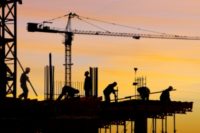Construction Site Noise: What’s the Risk?

With powerful machinery and heavy-duty tasks, construction sites are some of the noisiest places. Not only is the industry filled with loud sounds, it is also filled with noise-induced hazards. There are over 30 million construction workers who are exposed to prolonged noise on a daily basis.
Decibels (dBA) are the units used to measure and evaluate sound intensity. While human beings can register sounds above 140 decibels, any exposure to noise above 85 decibels is not recommended. Exposure time also comes into play — the longer your ears are subject to this noise level, the likelihood of permanent hearing loss rises.
The workplace risk for workers in construction is that loud noises on job sites damage hearing. According to the Centers for Disease Control and Prevention, 14% of workers report having a hearing difficulty due to the hazardous noise at their work. Construction workers operate equipment above the 85 dBA level. While it may be harmless to listen to this sounds for a few minutes, construction workers are exposed to long noise constantly for hours on any day.
Exposure to sounds at the acceptable level for more than two hours consistently can cause physical damage to your hearing. While regulations are helping to combat this, construction workers also need to wear hearing protection. 31% of workers report that they do not.
To put the risks of workplace noise into perspective, BigRentz created a scale of common construction noises compared to everyday sounds and highlighted tips for construction workers to prevent hearing loss in the infographic below.

Sources:
Industrial Noise Control | Centers for Disease Control and Prevention | Electronic Library of Construction Occupational Safety & Health | Hearing Doctors | OSHA Pocket Guide | University of Washington Department of Environmental and Occupational Health Sciences
Looking for a reprint of this article?
From high-res PDFs to custom plaques, order your copy today!





